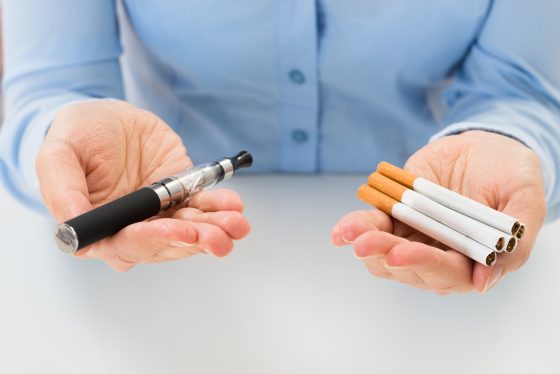Intended to stop adult smoking, vaping has become a harmful teen trend
Last week, the FDA announced its largest-ever enforcement action in the history of the agency. The goal? Stopping sales of e-cigarettes and vaping products to teens.
The agency warned Juul Labs and four other major manufacturers of the most popular devices that they have 60 days to halt sales to minors, or the FDA could remove their products from the market.
E-cigarettes, or electronic nicotine delivery devices, emerged in 2003 as a way to help adult smokers transition away from traditional cigarettes, which are the leading cause of preventable death in the U.S. While there is evidence that e-cigarettes have helped achieve that goal, there has been an alarming increase in teen use, which carries with it serious health risks.
FDA chief Scott Gottlieb, M.D., referred to e-cigarette use among teens as “an epidemic,” and said the rising sales of these products are “disturbing” and “dangerous” — especially to teens, who can quickly become addicted to nicotine. Studies show that teens who vape are more likely to smoke traditional cigarettes.
But are e-cigarettes all bad? Or are they a useful tool in helping adult smokers kick an even more dangerous habit? Here’s how doctors can sift through the hype and help their patients make the safest choices for their health.
How dangerous are e-cigs compared to traditional tobacco?
It’s clear that the message has gotten across about the dangers of traditional cigarettes—at least 80 percent of all age groups said that conventional smoking is “very harmful” to one’s health in a recent Gallup poll. However, opinions varied by age about whether vaping is dangerous. Only 22 percent of those under age 30 say vaping is “very harmful” to one’s health, compared to 40 percent or more of older age groups.
The poll also found that vaping has surpassed conventional smoking among people under 30. While 9 percent of all adult Americans say they regularly or occasionally vape, the rate jumps to 20 percent among those 18 to 29 years of age. Gallup finds that 16 percent of that age group smoke conventional cigarettes regularly or occasionally.
Kenneth Warner, Ph.D., of the University of Michigan School of Public Health, has said that the benefits of vaping to quit smoking far outweigh the health risks. His research found that nearly 3.3 million life-years could be saved by the year 2070 by using electronic nicotine delivery devices to quit conventional cigarettes.
Studies show that e-cigarettes contain toxic and carcinogenic chemicals particularly harmful to teens.
That is not to say that e-cigarettes are safe, however. Studies have shown that they contain toxic and carcinogenic chemicals. This is particularly concerning given the high usage rates by teens, “because exposure to toxicants during adolescence may result in greater harm than exposure in adulthood, given vulnerability to the acute and chronic effects of toxicants in general and from their cumulative exposure if started early,” stated a study published last year in the journal Pediatrics.
Because e-cigarettes have not been around very long, are unregulated, and new devices are emerging all the time, it’s difficult to get a grasp on how harmful the inhaled chemicals are.
“We are fortunate to know the risks of cigarette smoking, based on decades of epidemiological research,” Warner said. “It could take years before we know the full health impact of vaping, if indeed we ever will.”
Toxic chemicals and known health impacts to date
While the association between tobacco smoking and secondhand smoke and ocular surface disease is well known, according to the Optometry Times, less is known about the effects of “secondhand vape.”
E-cigarettes simulate tobacco smoking via a battery-powered heating element that vaporizes liquid nicotine, referred to as “e-liquids.” These e-liquids are being manufactured in a variety of candy and fruit flavors to appeal to teens. The problem is that the specific chemicals used are not listed on the ingredients of the vape liquid, but are labeled under the catch-all description of “flavorings,” according to the Pediatrics study. And these flavorings can react with one another or break down into potentially harmful chemicals.
Vaping has harmful health effects similar to those caused by secondhand tobacco smoke, and a certain chemical may cause chronic lung disease.
The Optometry Times article cites one study that found the integrated health damage from passive vaping was “lower than or comparable to those estimated for exposures to secondhand and thirdhand tobacco smoke.” Thirdhand smoke is defined as “residual nicotine and other chemicals left on indoor surfaces by tobacco smoke.” Acrolein and other compounds including formaldehyde are among the harmful chemicals.
According to the American Optometric Association fact sheet on Smoking, Vaping and Your Eyes, some e-cigarettes contain diacetyl, “which is a flavor similar to butter and used on microwave popcorn. This chemical can cause ‘popcorn lung disease.’” Similar to chronic obstructive pulmonary disease (COPD), “this disease can cause shortness of breath, coughing, and is irreversible.”
The bottom line
So what should you tell your patients about e-cigarettes? This is what internist and infectious disease specialist John Ross, M.D., of Harvard Medical School and Brigham and Women’s Hospital, has to say: “People who do not already smoke should avoid e-cigarettes.” Nicotine is known to increase the risk of high blood pressure and diabetes, and the flavoring agents may cause chronic lung disease and generate significant amounts of toxic chemicals.
Most importantly, educate patients about the risks of e-cigarette use by teens and young people. It’s only through greater awareness and better patient education that we have a chance of stemming this dangerous epidemic.
To find out more about how Rendia can help you deliver effective patient education, contact us today.


